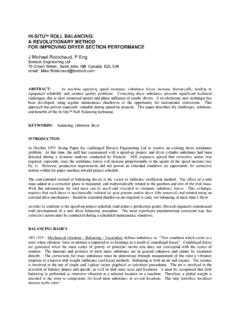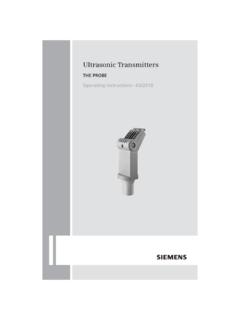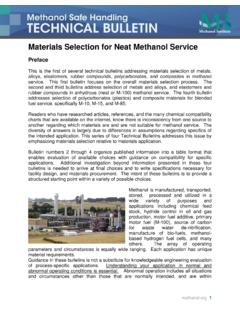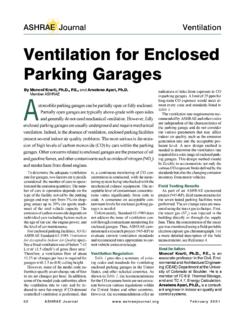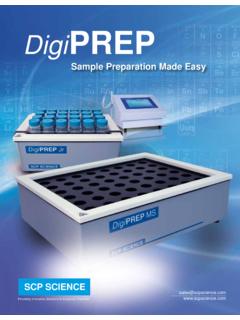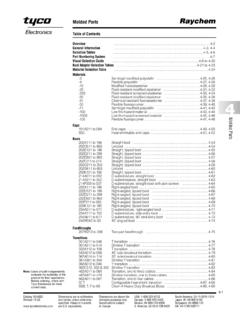Transcription of Paper16B Reference Standards - Bretech
1 Reference Standards for Vibration Monitoring and Analysis J Michael Robichaud, Bretech Engineering Ltd., 70 Crown Street, Saint John, NB Canada E2L 3V6 email: website: ABSTRACTS tandards are criteria established by authority, custom, or general consent. Good Reference Standards represent a broad consensus of opinion among users, and are therefore widely accepted and applied. Furthermore, Standards should be clear, concise, and easily understood. Numerous Standards exist to guide or govern vibration monitoring and analysis, including some that establish classifications for machinery vibration, how measurements should be made, and how the acquired data should be analyzed.
2 This paper will introduce a selection of applicable Reference Standards , and provide commentary and opinion on each with respect to suitability for various industrial applications. Keywords: vibration, Standards 1. INTRODUCTION Standards are documented agreements containing technical specifications or other precise criteria to be used consistently as rules, guidelines, or definitions of characteristics, to ensure that materials, products, processes and services are fit for their purpose. A good standard represents consensus of opinion, is easy to use, and contains no ambiguities or loopholes. 2. ISO Standards FOR VIBRATION MONITORING AND ANALYSIS The ISO Standards System In the field of machinery vibration monitoring and analysis, a variety of relevant Standards are developed and published by ISO (International Organization for Standardization).
3 ISO is a worldwide federation of national Standards bodies from 145 countries, and considers itself a bridge between the public and private sectors. A member body of ISO is the national body "most representative of standardization in its country". Only one such body for each country is accepted for ISO membership. Member bodies are entitled to participate and exercise full voting rights on any technical committee of ISO. In addition to ISO, various trade organizations such as National Electrical Manufacturers Association (NEMA) and American Petroleum Institute (API) have developed and published vibration Standards , which are widely accepted and applied (and therefore relevant).
4 In most cases, these Standards have been developed by consensus of consumers and manufacturers, and their use is considered voluntary. ISO Standards are developed by technical committees comprised of experts on loan from the industrial, technical, and business sectors. The experts participate as national delegations, selected by the ISO national member institute for their respective countries. Technical committees meet to discuss, debate, and argue until they reach consensus on a draft agreement, which is circulated as a Draft International Standard (DIS) to all ISO members for comment and balloting. After taking into account any feedback, the ISO members formulate their position on the draft standard.
5 Following an affirmative vote , the document, including any modifications, is re-circulated to the ISO members as a Final Draft International Standard (FDIS) for 2nd ballot. If that vote is positive, the document is then published by ISO as an International Standard. Most of the ISO Standards for machinery vibration monitoring and analysis are guided by technical committee TC108, Mechanical vibration and shock. TC108 is comprised of 22 Participating (P-member) countries and 25 Observer countries. As of May 2003, there are a total of 98 published ISO Standards related to TC108 and its SCs (subcommittees). Noteworthy subcommittees include; SC1, Balancing, including balancing machines, SC2, Measurement and evaluation of mechanical vibration and shock as applied to machines, vehicles and structures, and SC5, Condition monitoring and diagnostics of machines.
6 The stated scope of TC108 is Standardization in the field of mechanical vibration and shock and condition monitoring and diagnostics of machines, including; terminology; excitation by sources, such as machines and vibration and shock testing devices; elimination, reduction and control of vibration and shock, especially by balancing, isolation and damping; measurement and evaluation of human exposure to vibration and shock; methods and means of measurement and calibration; methods of testing; methods of measurement, handling and processing of the data required to perform condition monitoring and diagnostics of machines ISO Standards For Evaluation Of Vibration Severity Standards for evaluation of vibration severity are considered one of the most important activities of ISO/TC108.
7 Unfortunately, due to the range of machinery categories and classifications, it may also be the most confusing. A wide variety of published Standards describe acceptable vibration limits, including the ISO/7919 series (5 parts) Mechanical vibration of non-reciprocating machines Measurements on rotating shafts and evaluation criteria and the ISO/10816 series (6 parts) Mechanical vibration Evaluation of machine vibration by measurements on non-rotating parts As detailed in Table 1, ISO 7919-1 is the basic document describing the general requirements for measurement and evaluation of machinery vibration using shaft measurements.
8 Similarly, ISO 10816-1 is the basic document describing the general requirements for evaluating machinery vibration using casing and/or foundation measurements. Subsequent parts of each series of documents apply to different classes and types of machinery, and include specific evaluation criteria used to assess vibration severity. In accordance with ISO directives, Part 1, Procedures, 2001, an enquiry draft (DIS) is approved if a) a two-thirds majority of the votes cast by P-members of the technical committee or subcommittee are in favour, and b) not more than one quarter of the total votes cast are negative. ISO 7919 Series Mechanical vibration of non-reciprocating machines - Measurement on rotating shafts and evaluation criteria 7919-1:1996 Part 1: General Guidelines 7919-2: 2001 Part 2: Land-based steam turbines and generators in excess of 50 MW with normal operating speeds of 1500 r/min, 1800 r/min, 3000 r/min and 3600 r/min 7919-3: 1996 Part 3: Coupled industrial machines 7919-4: 1996 Part 4: Gas turbine sets 7919-5: 1997 Part 5: Machines set in hydraulic power generating and pumping plants ISO 10816 Series Mechanical vibration - Evaluation of machine vibration by measurements on non-rotating parts 10816-1: 1995 Part 1.
9 General Guidelines 10816-2: 2001 Part 2: Land-based steam turbines and generators in excess of 50 MW with normal operating speeds of 1500 r/min, 1800 r/min, 3000 r/min and 3600 r/min 10816-3: 1998 Part 3: Industrial machines with normal power above 15kW and nominal speeds between 120 r/min and 15000 r/min when measured in situ 10816-4: 1998 Part 4: Gas turbine sets excluding aircraft derivatives 10816-5: 2000 Part 5: Machines set in hydraulic power generating and pumping plants 10816-6: 1995 Part 6: Reciprocating machines with power ratings above 100 kW 10816-7 Part 7: Rotodynamic pumps for industrial application Table 1 ISO Standards for Evaluation of Vibration Severity The evaluation procedures in the ISO/7919 and ISO/10816 series of Standards are limited to broadband measurements, without Reference to frequency components or phase.
10 Measurement procedures are detailed in Part 1: General Guidelines of each series, including shaft relative, shaft absolute, and pedestal vibration measurements. At the May 13 16, 2003 meeting of ISO/TC108/SC2, Professor Hiroshi Kanki of Japan proposed Guidelines for selecting vibration evaluation methods by measurement on the rotating shaft and/or on non-rotating parts , referred to as the umbrella document . The scope of the umbrella document is to provide general guidelines for selecting the appropriate vibration Standards for a specific machinery classification. The proposed method includes 2 key evaluation criteria; 1) shaft displacement from the journal centerline, and 2) stiffness ratio of pedestal to bearing (which determines the ratio of the shaft relative vibration to the pedestal vibration), as detailed in Figures 1 and 2, below.
